Your CEMS data is inconsistent, leading to potential compliance failures and costly fines. You suspect the problem lies in getting a clean, unmodified gas sample to your analyzer.
The solution is a high-performance micro pump. It's the heart of the CEMS, responsible for drawing a precise gas sample from the source and delivering it reliably, ensuring the data you collect is accurate and defensible.

As a specialist in pump technology, I often speak with engineers designing and maintaining CEMS units. They face immense pressure to ensure accuracy and uptime because the stakes—both financial and environmental—are incredibly high. The questions they ask are always sharp and to the point, focused on reliability and performance in harsh conditions. I've compiled the top ten questions here to share that crucial knowledge more broadly.
1. Why Are Micro Pumps Essential for CEMS?
You see a complex analyzer and think that's the whole system. But without a way to get a gas sample to it, the analyzer is useless, leaving you blind to your actual emissions.
A micro pump is the active component that pulls a representative gas sample from the smokestack, through filters and conditioning systems, and delivers it to the analyzer sensor for accurate, real-time measurement.
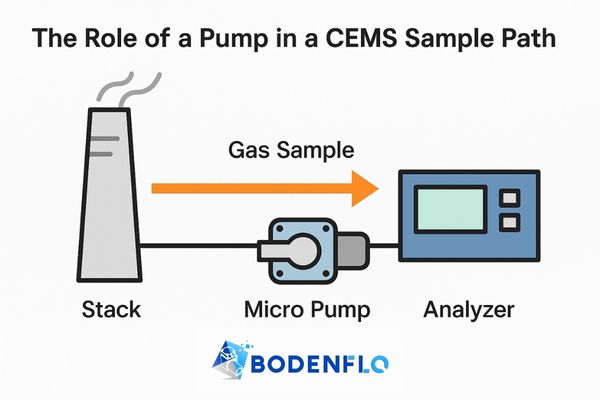
The Heart of the System
A CEMS is not a passive sensor you just stick in a smokestack. It's an active sampling system1. The analyzer itself is often located in a controlled environment, away from the heat and vibration of the emission source. The micro pump provides the motive force—the suction or vacuum—to make this happen. Its job is to continuously draw a sample at a steady, predictable rate. This ensures the gas reaching the analyzer is a true and timely representation of what's being emitted. Without a reliable pump2, you could have flow drops, delays, or air leaks, all of which would corrupt the data and make your multi-thousand-dollar analyzer worthless for compliance reporting. The pump isn't an accessory; it's the engine that drives the entire measurement process.
2. How Do Micro Pumps Handle Corrosive Gases?
You know that flue gas is full of corrosive compounds like SOx and NOx. You're worried that these chemicals will quickly eat away at the pump's internal parts, causing a catastrophic failure.
They survive by using highly resistant materials. Pump heads are made from plastics like PPS, and diaphragms use advanced elastomers like EPDM or Viton (FKM), which are specifically chosen to withstand chemical attack.
Engineering for Hostile Environments
Standard plastics and rubbers would degrade in days when exposed to acidic stack gases. That's why material selection is the most critical design aspect for a CEMS pump. Here's a breakdown of the materials we use and why:
- Pump Head (Wetted Part): We often use PPS (Polyphenylene Sulfide)3. This is an advanced engineering thermoplastic known for its exceptional chemical resistance, even at elevated temperatures. It doesn't swell, soften, or crack when exposed to the typical CEMS gas matrix.
- Diaphragm & Valves (Wetted Parts): This is the flexible heart of the pump. The choice here is critical.
- EPDM (Ethylene Propylene Diene Monomer): Offers excellent resistance to a wide range of chemicals and performs well in the presence of moisture.
- Viton®/FKM (Fluoroelastomer)4: Provides superior resistance to a broader spectrum of aggressive chemicals and hydrocarbons, often considered a premium choice for the most demanding applications.
By matching these materials to the specific chemical profile of the emissions, we build a pump that can operate reliably for thousands of hours.
3. What Role Do Pumps Play in Sample Gas Conditioning?
Your gas sample is hot, wet, and dirty. If this raw gas hits the analyzer, it will be destroyed. You know you need a conditioning system, but how does the pump fit in?
The micro pump is the engine that pulls the gas through the entire conditioning train—including particulate filters, coolers, and moisture traps—before delivering the clean, dry sample to the analyzer for a reliable reading.
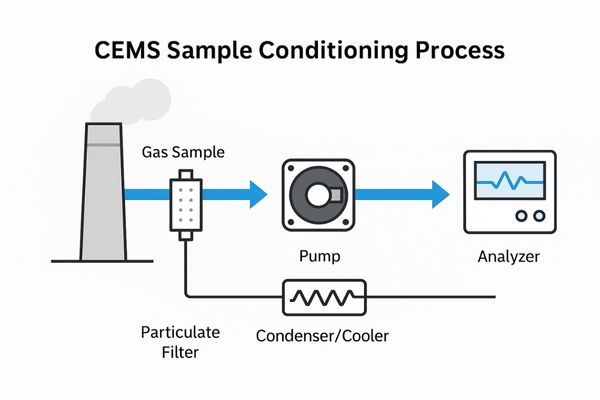
Pulling Through the Obstacles
A sample conditioning system is a series of obstacles designed to protect the analyzer. Each component adds a "pressure drop5," meaning it takes force to pull the gas through it. The pump must provide enough vacuum to overcome the total pressure drop of the entire system. This includes:
- Particulate Filter: The first line of defense against soot and ash. This can create significant flow resistance as it gets dirty.
- Sample Cooler (Condenser): Chills the gas to a precise dew point (e.g., 4°C) to make water vapor condense into liquid.
- Moisture Trap/Drain: Removes the condensed water from the sample stream.
- Tubing: Long runs of tubing create their own friction losses.
The pump must be powerful enough to handle the "worst-case" scenario—when the filter is dirty and resistance is highest—while still maintaining a stable flow rate. This is why selecting a pump with an adequate vacuum rating6 is not just a suggestion; it's a requirement for the system to function.
4. Can Micro Pumps Maintain a Stable Flow for Accurate Readings?
You know that analyzer readings can be flow-sensitive. If the flow rate fluctuates, your measured gas concentration will drift, creating false readings and inaccurate compliance reports.
Yes, high-quality diaphragm pumps provide exceptionally stable, low-pulsation flow. For ultimate precision, they can be controlled by the CEMS's main computer using PWM signals to maintain a perfectly constant flow rate.
The Foundation of Consistency
Consistency is key in scientific measurement. In CEMS, a stable flow rate ensures that the amount of gas passing over the analyzer's sensor per unit of time is constant. A well-designed diaphragm pump is inherently stable due to its consistent mechanical motion. However, for the highest level of accuracy, a simple on/off operation isn't enough.
This is where advanced motor control comes in. Many of our pumps, especially those with brushless DC (BLDC) motors, feature a PWM (Pulse Width Modulation) speed control input7. This allows the main CEMS controller to act as the "brain." The controller can monitor the flow rate with a separate sensor and, if it deviates, send a signal to the pump to speed up or slow down just enough to bring the flow back to the precise setpoint. This creates a closed-loop control system8, guaranteeing rock-solid flow stability and, therefore, the most accurate and defensible emissions data.
5. What is the Expected Lifespan of a CEMS Pump in 24/7 Operation?
The "C" in CEMS stands for continuous. You can't afford to have a pump die after just a few months, forcing an emergency shutdown and a potential breach of your operating permit.
With a brushless motor, a CEMS micro pump is designed for this marathon. Lifespans of over 10,000 hours of continuous operation are standard, ensuring more than a full year of reliable, 24/7 service before maintenance.
Brushless Motors Make the Difference
The single biggest factor in a pump's lifespan is its motor. Traditional brushed DC motors have carbon brushes that physically rub against the commutator to make the motor turn. This friction creates wear, dust, and heat. In continuous 24/7 operation, these brushes will wear out in a matter of months (typically 1,000-3,000 hours).
This is unacceptable for CEMS. That's why we exclusively recommend and use Brushless DC (BLDC) motors9 for these applications. BLDC motors are electronically commutated. There are no brushes to wear out. The benefits are enormous:
- Massively Increased Lifespan10: 10,000 hours is a conservative baseline. Many run for much longer.
- Higher Efficiency: More energy is converted to motion, not wasted as heat.
- No Carbon Dust: Prevents contamination of the motor and surrounding electronics.
- Quieter Operation: Less friction means less noise.
Choosing a pump with a brushless motor is the single most important decision for ensuring long-term reliability and minimizing unscheduled downtime.
6. How Easy is it to Maintain or Replace a Micro Pump?
You know that even the best components will eventually need service. You need a pump that can be swapped out quickly and easily during a scheduled maintenance window, without a complex, time-consuming procedure.
They are designed for modularity. Typically mounted with a few screws and connected with simple push-on tube fittings and an electrical connector, a trained technician can replace a micro pump in minutes.
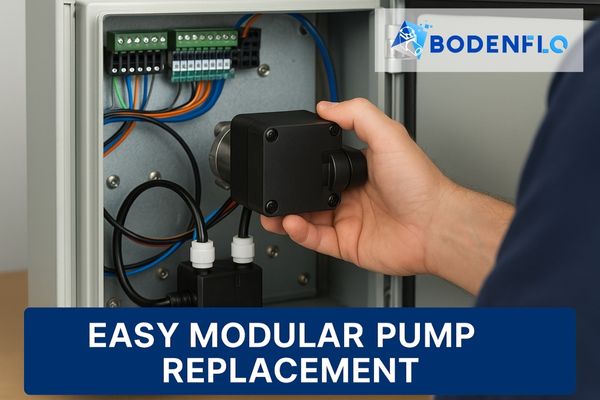
Designing for Serviceability
Downtime is the enemy of any continuous process. We understand that our pumps are critical components within a larger system, so we design them for rapid service. The key is a modular approach11. The pump is a self-contained unit, not an integrated piece that requires disassembling the entire CEMS box.
A typical replacement procedure12 looks like this:
- Power Down: Turn off the power to the CEMS unit.
- Disconnect: Unplug the simple electrical connector. Pull the inlet and outlet tubes off the barbed fittings.
- Unmount: Remove the 2 or 4 screws holding the pump's mounting bracket to the chassis.
- Install New Pump: Simply reverse the process. Mount the new pump, push the tubes on, and plug in the connector.
- Power Up & Test: The system is back online.
This entire process can often be completed in under 15 minutes, turning a potential major shutdown into a minor, planned maintenance task.
7. Why is an Oil-Free Pump Critical for CEMS?
You're pulling a precise chemical sample. The last thing you want is for the pump itself to add contaminants, like oil aerosol, which could damage the sensitive analyzer or skew the readings.
Diaphragm pumps are oil-free by design. The mechanism is sealed and uses a flexible diaphragm, not a lubricated piston, to move gas. This guarantees zero contamination of the sample stream from the pump itself.
Preserving Sample Integrity
The entire purpose of a CEMS is to accurately measure the chemical composition of a gas stream. Any substance introduced by the sampling system itself compromises the integrity of that measurement. Many pump technologies, like piston or rotary vane pumps, require oil for lubrication and sealing. This oil can become an aerosol—a fine mist—that gets mixed in with the gas sample.
This oil aerosol is a disaster for a CEMS analyzer13. It can:
- Coat a sensor's surface: This blinds the sensor, causing its readings to drift or fail completely.
- React with sample gases: This can create new compounds that weren't in the original sample, leading to false readings.
- Clog fine filters and orifices: This can restrict flow and cause system failure.
Diaphragm pumps14 completely avoid this problem. The moving parts are isolated from the gas path by the diaphragm. There is no oil, grease, or lubricant anywhere near the sample, ensuring that the gas that enters the pump is the same gas that exits it.
8. What Vacuum and Flow Rates are Needed for CEMS?
You're designing a new system and need to specify the pump. You're not sure how much power is "enough" and don't want to under-spec or over-spec the component.
Typically, a CEMS requires a vacuum of -30 kPa to -80 kPa to overcome system resistance. A free flow rate of 5 to 15 L/min is usually sufficient for most standard analyzers.
Finding the Sweet Spot
Pump selection is a balancing act. You need enough power, but getting a pump that's massively oversized is inefficient and expensive. Let's break down the key performance parameters:
- Maximum Vacuum (kPa)15: This is the pump's "strength." It determines its ability to pull the sample through the resistance of filters and tubing. You must calculate the total pressure drop of your system and choose a pump with a max vacuum rating significantly higher than that to provide a safety margin. A pump rated for -80 kPa is a robust choice for complex systems.
- Open Flow Rate (L/min): This is the volume of gas the pump can move with zero resistance. While you'll never operate at open flow, it's a key indicator of the pump's capacity. The actual operating flow will be lower, depending on the system's resistance. A pump with a 10-15 L/min open flow rating generally provides enough capacity to supply the 1-2 L/min required by the analyzer even after accounting for system pressure drops.
I always advise clients to map their system's resistance curve and overlay it on the pump's performance curve to find the exact operating point.
9. How Do I Select the Right Micro Pump for My Specific CEMS Application?
You understand the basics, but your application has unique challenges. You're monitoring a particularly wet gas stream or need to fit the pump into an extremely tight space. How do you choose the perfect model?
You select it by matching the pump's specifications—materials, performance, and motor type—to your specific system requirements. It's a process of prioritizing the most critical factors for your application.
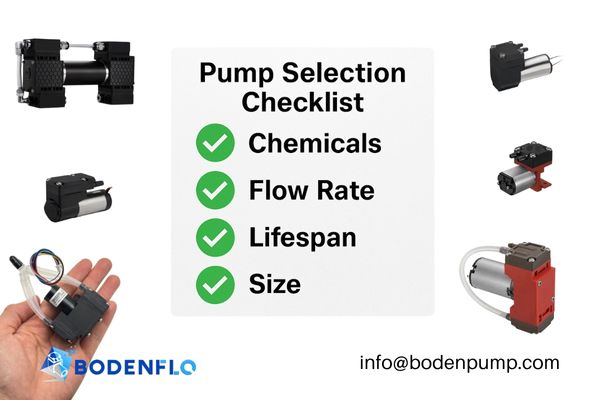
A Prioritized Selection Process
Choosing the right pump isn't about finding the "best" pump; it's about finding the pump that is best for you. I walk my clients through a simple decision-making table.
| Priority Factor | Question to Ask | BODENFLO Solution |
|---|---|---|
| 1. Chemical Resistance1 | What specific gases (SO₂, NOₓ, etc.) are in my sample? | Choose the right wetted materials (PPS head, EPDM/Viton diaphragm). |
| 2. Performance | What is my system's total pressure drop and required flow rate? | Select a pump model whose performance curve meets your operating point. |
| 3. Lifespan | Does this need to run 24/7 with minimal downtime? | Always choose a brushless (BLDC) motor. This is non-negotiable for CEMS. |
| 4. Control | Do I need to maintain a precise, actively managed flow rate? | Select a BLDC pump with a PWM speed control input for closed-loop control. |
| 5. Physical Constraints | How much space and power do I have available? | Compare the dimensions, weight, and voltage/current draw of suitable models. |
By working through these factors in order, you can systematically narrow down the options and select the ideal pump with confidence.
10. How Do Pumps Integrate with CEMS Control Systems?
You have a central PLC or computer running your CEMS. You don't want the pump to be a "dumb" component; you want it to be an integrated part of your smart system.
Modern micro pumps integrate seamlessly. They operate on standard DC voltages (12V/24V) from the system's power supply and can receive PWM speed control signals from a PLC, allowing for intelligent, real-time performance adjustments.
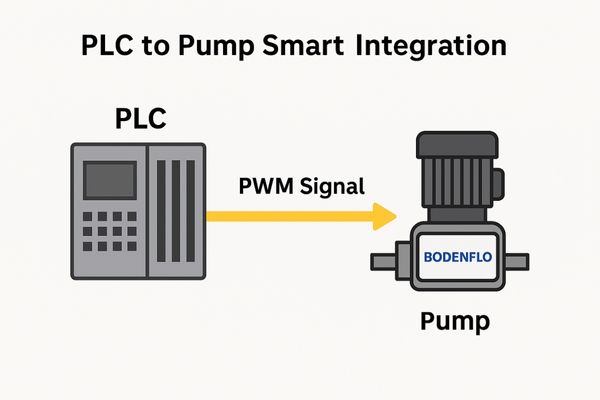
From Component to System Partner
A modern CEMS is a smart, interconnected system. The pump is no exception. Integration happens on two levels: power and control.
- Power: Our pumps run on standard low DC voltages (typically 12V or 24V). This means they can be powered directly by the same central power supply that runs the rest of the CEMS electronics and sensors. This simplifies the wiring and overall system design significantly.
- Control: This is where the intelligence lies. Our brushless pumps feature a PWM (Pulse Width Modulation16) input. The system's central PLC sends a simple signal to this input to command the pump's speed. A high-duty-cycle signal tells the pump to run faster; a low-duty-cycle signal tells it to slow down. This allows for precise, real-time control over the flow rate, turning the pump into a responsive partner in the CEMS data collection process.
Conclusion
A reliable micro pump is non-negotiable for accurate CEMS. By choosing the right materials, motor, and performance, you ensure sample integrity, system uptime, and confident compliance.
At BODENFLO, we help OEMs and integrators select and customize the ideal micro pump for their CEMS applications — whether it’s for SO₂, NOₓ, VOCs, or more.
📩 Ready to upgrade your CEMS performance?
Contact our engineering team at info@bodenpump.com or visit https://bodenpump.com to explore high-performance, maintenance-free micro pumps designed for 24/7 environmental monitoring.
-
Understanding active sampling systems is crucial for accurate emissions monitoring and compliance. ↩ ↩
-
A reliable pump is essential for ensuring accurate data collection in emissions analysis, impacting compliance and reporting. ↩
-
Explore this link to understand why PPS is favored for its chemical resistance and durability in harsh environments. ↩
-
Discover the advantages of Viton®/FKM in demanding applications and how it outperforms other materials. ↩
-
Understanding pressure drop is crucial for optimizing system performance and ensuring efficient gas flow. ↩
-
Choosing the right vacuum rating is essential for maintaining system stability and performance under varying conditions. ↩
-
Understanding PWM can enhance your knowledge of motor control systems, crucial for achieving precision in applications like CEMS. ↩
-
Exploring closed-loop control systems will deepen your grasp of automation and accuracy in various engineering fields. ↩
-
Explore the benefits of BLDC motors to understand why they are crucial for pump longevity and efficiency. ↩
-
Learn how BLDC motors contribute to significantly longer pump lifespans, ensuring reliability and reducing maintenance costs. ↩
-
Understanding the modular approach can enhance your maintenance efficiency and reduce downtime significantly. ↩
-
Exploring the replacement procedure can help you streamline your maintenance tasks and minimize operational disruptions. ↩
-
Understanding CEMS analyzers is crucial for accurate gas measurement, ensuring reliable data for environmental monitoring. ↩
-
Exploring diaphragm pumps reveals their benefits in maintaining sample integrity, essential for accurate gas analysis. ↩
-
Understanding Maximum Vacuum is crucial for selecting the right pump, ensuring efficiency and effectiveness in your system. ↩
-
Understanding PWM is crucial for optimizing pump control in CEMS, enhancing efficiency and performance. ↩


